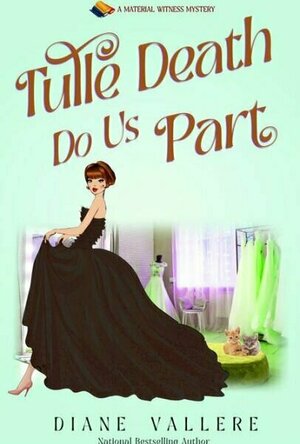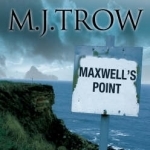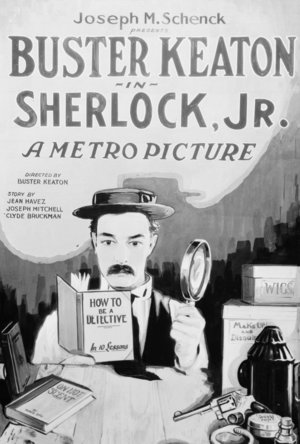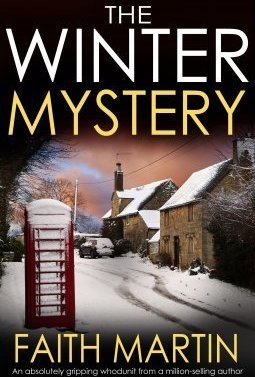
Take the Honey and Run
Book
As a successful mystery author, Bailey Briggs writes about murder, but nothing prepares her for...

Gone for Good
Book
Gone For Good is the first in a new mystery series from award-winning author Joanna Schaffhausen,...

Tulle Death Do Us Part
Book
Polyester Monroe, quirky amateur sleuth and proud owner of Material Girl, the most colorful fabric...
Kirk Bage (1775 KP) rated Sherlock, Jr. (1924) in Movies
Jan 28, 2021
Most memorable is the cinema scene where Keaton’s love sick amateur sleuth tries to hide by actually entering the screen – a trick paid homage to in many movies since, including Woody Allen’s The Purple Rose of Cairo. It is astonishing to think he not only thought of doing this in 1924, but also pulled it off with jaw-dropping special effects for the time. It’s also really funny. You don’t have to force a laugh because you feel you should, it is still clever and amusing almost 100 years later. In fact, the entire 46 minute print still looks so good it is hard to believe it is that old in any way. Surely one of a handful of half length films from the period that will always be watched for what they are and not just museum pieces.
Heather Cranmer (2721 KP) created a post
May 20, 2022
Janine O (2 KP) rated The Perfect Husband in Books
Oct 23, 2017
I love reading about unsolved mysteries, solved mysteries and everything between. I read books, listen to podcasts, and belong to several amateur sleuth blogs. Yes. I even belong to the Hunt A Killer curated box mystery. There. I've admitted it.
In the world of true crime my biggest passion is serial killers. Cliche, perhaps, but it's true.
I, like many, always asked myself about the family that surrounds serial killers; both before and after they are caught. Most importantly, what about the wives of serial killers? Lisa Gardner attempts to answer this question.
The thing I love most about Lisa Gardner's work is that she takes the time and effort to research before she even puts words to page. It is clear by the lingo that she uses and the characters that she builds that Gardner talked to actual law enforcement officials, and really listens to what they do.
The main character is the abused and traumatized wife of a sadistic serial killer. She is attempting to learn to protect herself and in so doing turns tot he meanest mercenary that she can find to teach her. She wants to learn to fight and shoot so that she can handle the man that law enforcement lost, the husband who is obsessed with killing her.
I absolutely adored this book, and immediately went out and bought three more of her novels.
The main female character is suffering from battered woman's syndrome. She is trying her best to cast off the mental and physical abuse she suffered at the hands of her narcissistic and criminal spouse.
The mercenary she turns to...has issues. He is, in his own way, as broken and screwed up as our heroine. But, through her, he begins to give a damn again.
The killer, our heroine's former husband, is so fantastically well done that it is almost too easy to picture him on the front page of a newspaper, or scattered across social media blogs.
It's fantastic. I recommend this to anyone who likes female protagonists, serial killers, or thrillers.

Maxwell's Point
Book
With girlfriend DS Jacquie Carpenter back at work and little baby Nolan rapidly growing into a...
Midge (525 KP) rated The Winter Mystery in Books
Mar 18, 2019
Best-seller author Faith Martin has also written the ‘Detective Hillary Greene’ mysteries.
First, we are introduced to Jenny Starling who is spending Christmas in a snowed-in country house cooking all the traditional food she loves, however, the family she’s working for are not full of the seasonal spirit. On Christmas Eve, someone is found dead on the kitchen table and the head of the family is blaming Jenny! But with an incompetent detective called in, and seemingly no motive for the murder, Jenny will have to turn amateur sleuth again. She will stop at nothing to clear her name and find the perpetrator.
Faith Martin’s writing skills set the scene beautifully for this novel. The house is a large, charming, Cotswold-stone, Georgian farmhouse in rural Oxford, complete with stables, outhouses, a cobbled courtyard and a resident sheepdog.
Faith Martin’s character development is wonderful, particularly that of Jenny who is an impressive woman and in her late twenties. Curvaceous and sexy, she’s a modern single woman, living and loving life as a travelling cook. She is happy travelling the country catering for different events and cooking great food. She doesn’t like having to divert her attention from baking delicious cakes or creating a new sauce recipe by having to solve murders. She is great at reading people and unmasking killers, always with a good dose of humour.
There are many suspects in this mystery, with clues and lots of red herrings to keep the reader guessing. It was a thoroughly satisfying read and I often found myself asking the same questions as Jenny and I was kept in suspense to the end. The pacing in "The Winter Mystery" was very good and I never lost interest, as it wasn't long before something intriguing would happen. Things came together for a fulfilling finish and wrapped everything up very neatly.
I'm definitely looking forward to the next novel featuring Jenny Starling and other books by the author, Faith Martin. "The Winter Mystery" whets your appetite for more to come.
My thanks to #NetGalley, Joffe Books and the author for providing me with a free advanced copy of #TheWinterMystery.

Murder at Sea
Book
Fear naut, the next Destinations Murder collection is here: Murder at Sea. Third in this...
Jamie (131 KP) rated Not a Sound in Books
Aug 15, 2017
Having read a few of Gudenkauf’s books I can’t help but notice a pattern in her stories that bothers me. In every one of her books that I’ve read the main character always has some connection to law enforcement that gets her “in” an investigation, even though she really shouldn’t see or know any of this information legally. Even worse, the main character always ends up interfering in an investigation by giving the police false leads. I don’t mind following an amateur sleuth that makes mistakes in their investigation it starts to feel repetitive with these characters suspecting everyone of everything.
It’s a very obvious attempt at adding some red herrings to the story to keep the mystery going but it becomes very noticeable once you’re acquainted with the author’s writing style. It is because of this that the story becomes a little predictable and the culprit can be guessed almost as soon as they are introduced. It seems that Gudenkauf may have noticed this, at least, as the character is reprimanded for her meddling and I appreciated this.
Despite this, however, the story kept me interested in finding out the how and they why rather than the who. Gudenkauf has a way of immersing the reader into the story and the characters and it is something that I admire about her work. Her skill with pacing is perfect despite the sometimes overwhelming issues with dangerous interference that is present in many of her books. It is because of these two factors that make her books so hit or miss with me.
This book was a definite hit and I’m so glad that I took a chance on it. It’s rare to find a main character that is disabled in some way and so I was happy that I found this book. I love the commentary that this book has about the importance of trust and empathy in the health industry, a topic that I wish was addressed more often. Even with the mild plot issues it’s worthwhile read for the intense mystery and wonderful cast of characters, especially Amelia and Stitch.



